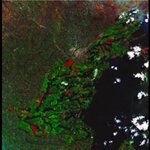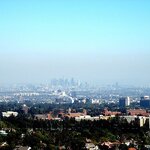A new study in
Nature Climate Change challenges the assumption in climate models that climate is the primary driver of how quickly organic matter decomposes in different regions.
A long-term analysis conducted across several sites in the eastern United States found that local factors — from levels of fungal colonization to the specific physical locations of the wood — play a far greater role than climate in wood decomposition rates and the subsequent impacts on regional carbon cycling.
Because decomposition of organic matter strongly influences the storage of carbon, or its release into…
Atmospheric

Do you prefer to own a DVD, rather than wondering if Netflix will remove whatever show you wanted to watch this week? If you buy or rent, rather than streaming, you are contributing to billions of tons of carbon going into the atmosphere.
A new paper in Environmental Research Letters claims that streaming is much better for the environment, requiring less energy and emitting less carbon dioxide (CO2), than DVD renting, buying and viewing, even when you factor in the energy cost of computers and laptops versus older DVD players. It's the driving to rent that makes a big difference, though…

Soil from thousands of years ago that is now deeply buried has been found to be rich in carbon, adding a new dimension to figuring out the planet's carbon cycle.
The element carbon comes in many forms and cycles through the environment – land, sea and atmosphere – just as water in various forms cycles through the ground, oceans and the air. Scientists have long known about the carbon storage capacity of soils, the potential for carbon sequestration, and that carbon in soil can be released to the atmosphere through microbial decomposition.
The new results suggest that deep soils can contain…

The weather is big news. No matter what is happening, too little or too much, someone is talking about that and then linking it to long-term climate disruption. The UN IPCC says not do to that, but if people will anyway, the big question is; how much accuracy is possible?
Rainfall is important and therefore a topic of intense debate. While we historically haven't been able predict it, we can use modern weather satellites to monitor it, and so that has become a widely-practiced technique. That is not without pitfalls. Yet how accurate are claims about past rainfall? And can satellites do…

There is new evidence to suggest that lightning on Earth is triggered by cosmic rays from space - and energetic particles from the Sun.
How so? They linked increased thunderstorm activity on Earth and streams of high-energy particles accelerated by the solar wind.
Conclusion: Particles from space help trigger lightning bolts.
Writing Environmental Research Letters, the researchers from Reading's Department of Meteorology found a substantial and significant increase in lightning rates across Europe for up to 40 days after the arrival of high-speed solar winds, which can travel at more…

The climate hockey stick, a popular visual metaphor for climate change, has received considerable attention. It depicts a slightly cooling trend in the Northern Hemisphere from 1000 A.D. until 1900 A.D. and then swings sharply upward in the last 80 years. It was created using tree ring data for the older timeframes but not recently - after 1960, tree ring data showed a cooling trend so it was replaced.
Clearly that was not correct but if tree rings don't detect the modern warming trend, they might also have 'missed' warming episodes in the past - we know that the climate is not cooler…

There may be a reason why emissions regulations that reduced air pollutants like sulfur dioxide, nitrogen dioxide and carbon monoxide haven't really led to a drop in ozone. A report from 2012 found that ambient levels of fine particulate matter had declined by 20 to 60 percent since 2001 but ozone had continued to rise in that same period, up 20 percent.
A new paper believes it's because of rising temperatures. Ozone pollution across the continental United States will become far more difficult to keep in check and Americans face the risk of a 70 percent increase in unhealthy summertime…

A new study has created the first detailed look at global land surface warming trends over the last 100 years, illustrating precisely when and where different areas of the world started to warm up or cool down.
Result: the world is indeed getting warmer but not everywhere and not at the same rate.
This probably took a few scientists by surprise and many journalists, but outside the IPCC this is exactly what was known to be happening..
"Global warming was not as understood as we thought," said Zhaohua Wu, an assistant professor of meteorology at Florida State University, who led a team of…

Throughout the 1980s and 1990s, biofuels - ethanol - was touted as the savior of the environment if it replaced fossil fuels. Former Vice-President Al Gore of Tennessee advocated them, environmental corporations pushed for lobied and finally, in 2005, they were mandated and subsidized.
It quickly became evident that the claims about ethanol were not based on science.
Ethanol was already big business in Brazil and given the benefit of time, scholars can now analyze their air quality as a result of switching from gasoline - and then back. Oddly, ethanol became too expensive so …

A new paper out today says that increased levels of carbon dioxide in the atmosphere cause soil microbes to produce more carbon dioxide, accelerating climate change.
Two Northern Arizona University researchers led the study, which challenges previous understanding about how carbon accumulates in soil. Increased levels of CO2 accelerate plant growth, which causes more absorption of CO2 through photosynthesis.
Until now, the accepted belief was that carbon is then stored in wood and soil for a long time, slowing climate change. Yet this new research suggests that the extra carbon provides fuel…